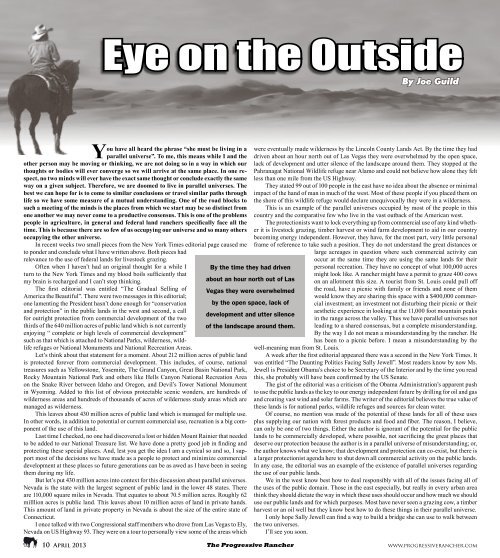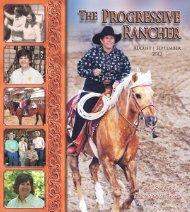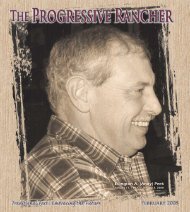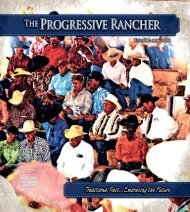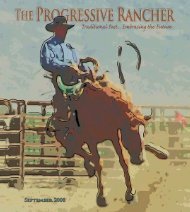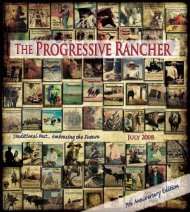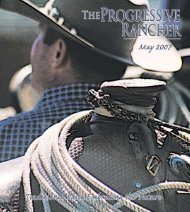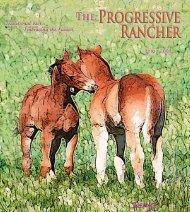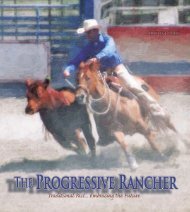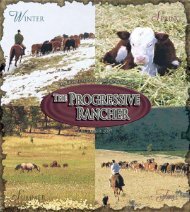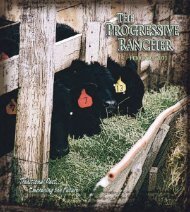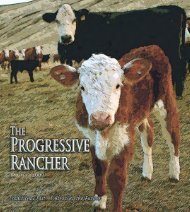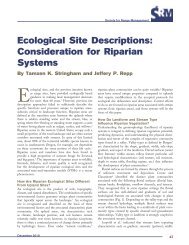NCA 2009 President's Award Recipient - The Progressive Rancher ...
NCA 2009 President's Award Recipient - The Progressive Rancher ...
NCA 2009 President's Award Recipient - The Progressive Rancher ...
Create successful ePaper yourself
Turn your PDF publications into a flip-book with our unique Google optimized e-Paper software.
By Joe Guild<br />
You have all heard the phrase “she must be living in a<br />
parallel universe”. To me, this means while I and the<br />
other person may be moving or thinking, we are not doing so in a way in which our<br />
thoughts or bodies will ever converge so we will arrive at the same place. In one respect,<br />
no two minds will ever have the exact same thought or conclude exactly the same<br />
way on a given subject. <strong>The</strong>refore, we are doomed to live in parallel universes. <strong>The</strong><br />
best we can hope for is to come to similar conclusions or travel similar paths through<br />
life so we have some measure of a mutual understanding. One of the road blocks to<br />
such a meeting of the minds is the places from which we start may be so distinct from<br />
one another we may never come to a productive consensus. This is one of the problems<br />
people in agriculture, in general and federal land ranchers specifically face all the<br />
time. This is because there are so few of us occupying our universe and so many others<br />
occupying the other universe.<br />
In recent weeks two small pieces from the New York Times editorial page caused me<br />
to ponder and conclude what I have written above. Both pieces had<br />
relevance to the use of federal lands for livestock grazing.<br />
Often when I haven’t had an original thought for a while I<br />
turn to the New York Times and my blood boils sufficiently that<br />
my brain is recharged and I can’t stop thinking.<br />
<strong>The</strong> first editorial was entitled “<strong>The</strong> Gradual Selling of<br />
America the Beautiful”. <strong>The</strong>re were two messages in this editorial;<br />
one lamenting the President hasn’t done enough for “conservation<br />
and protection” in the public lands in the west and second, a call<br />
for outright protection from commercial development of the two<br />
thirds of the 640 million acres of public land which is not currently<br />
enjoying “ complete or high levels of commercial development”<br />
such as that which is attached to National Parks, wilderness, wildlife<br />
refuges or National Monuments and National Recreation Areas.<br />
Let’s think about that statement for a moment. About 212 million acres of public land<br />
is protected forever from commercial development. This includes, of course, national<br />
treasures such as Yellowstone, Yosemite, <strong>The</strong> Grand Canyon, Great Basin National Park,<br />
Rocky Mountain National Park and others like Hells Canyon National Recreation Area<br />
on the Snake River between Idaho and Oregon, and Devil’s Tower National Monument<br />
in Wyoming. Added to this list of obvious protectable scenic wonders, are hundreds of<br />
wilderness areas and hundreds of thousands of acres of wilderness study areas which are<br />
managed as wilderness.<br />
This leaves about 430 million acres of public land which is managed for multiple use.<br />
In other words, in addition to potential or current commercial use, recreation is a big component<br />
of the use of this land.<br />
Last time I checked, no one had discovered a lost or hidden Mount Rainier that needed<br />
to be added to our National Treasure list. We have done a pretty good job in finding and<br />
protecting these special places. And, lest you get the idea I am a cynical so and so, I support<br />
most of the decisions we have made as a people to protect and minimize commercial<br />
development at these places so future generations can be as awed as I have been in seeing<br />
them during my life.<br />
But let’s put 430 million acres into context for this discussion about parallel universes.<br />
Nevada is the state with the largest segment of public land in the lower 48 states. <strong>The</strong>re<br />
are 110,000 square miles in Nevada. That equates to about 70.5 million acres. Roughly 62<br />
milllion acres is public land. This leaves about 10 million acres of land in private hands.<br />
This amount of land in private property in Nevada is about the size of the entire state of<br />
Connecticut.<br />
I once talked with two Congressional staff members who drove from Las Vegas to Ely,<br />
Nevada on US Highway 93. <strong>The</strong>y were on a tour to personally view some of the areas which<br />
By the time they had driven<br />
about an hour north out of Las<br />
Vegas they were overwhelmed<br />
by the open space, lack of<br />
development and utter silence<br />
of the landscape around them.<br />
were eventually made wilderness by the Lincoln County Lands Act. By the time they had<br />
driven about an hour north out of Las Vegas they were overwhelmed by the open space,<br />
lack of development and utter silence of the landscape around them. <strong>The</strong>y stopped at the<br />
Pahranagat National Wildlife refuge near Alamo and could not believe how alone they felt<br />
less than one mile from the US Highway.<br />
<strong>The</strong>y stated 99 out of 100 people in the east have no idea about the absence or minimal<br />
impact of the hand of man in much of the west. Most of these people if you placed them on<br />
the shore of this wildlife refuge would declare unequivocally they were in a wilderness.<br />
This is an example of the parallel universes occupied by most of the people in this<br />
country and the comparative few who live in the vast outback of the American west.<br />
<strong>The</strong> protectionists want to lock everything up from commercial use of any kind whether<br />
it is livestock grazing, timber harvest or wind farm development to aid in our country<br />
becoming energy independent. However, they have, for the most part, very little personal<br />
frame of reference to take such a position. <strong>The</strong>y do not understand the great distances or<br />
large acreages in question where such commercial activity can<br />
occur at the same time they are using the same lands for their<br />
personal recreation. <strong>The</strong>y have no concept of what 100,000 acres<br />
might look like. A rancher might have a permit to graze 400 cows<br />
on an allotment this size. A tourist from St. Louis could pull off<br />
the road, have a picnic with family or friends and none of them<br />
would know they are sharing this space with a $400,000 commercial<br />
investment; an investment not disturbing their picnic or their<br />
aesthetic experience in looking at the 11,000 foot mountain peaks<br />
in the range across the valley. Thus we have parallel universes not<br />
leading to a shared consensus, but a complete misunderstanding.<br />
By the way I do not mean a misunderstanding by the rancher. He<br />
has been to a picnic before. I mean a misunderstanding by the<br />
well-meaning man from St. Louis.<br />
A week after the first editorial appeared there was a second in the New York Times. It<br />
was entitled “<strong>The</strong> Daunting Politics Facing Sally Jewell”. Most readers know by now Ms.<br />
Jewell is President Obama’s choice to be Secretary of the Interior and by the time you read<br />
this, she probably will have been confirmed by the US Senate.<br />
<strong>The</strong> gist of the editorial was a criticism of the Obama Administration’s apparent push<br />
to use the public lands as the key to our energy independent future by drilling for oil and gas<br />
and creating vast wind and solar farms. <strong>The</strong> writer of the editorial believes the true value of<br />
these lands is for national parks, wildlife refuges and sources for clean water.<br />
Of course, no mention was made of the potential of these lands for all of these uses<br />
plus supplying our nation with forest products and food and fiber. <strong>The</strong> reason, I believe,<br />
can only be one of two things. Either the author is ignorant of the potential for the public<br />
lands to be commercially developed, where possible, not sacrificing the great places that<br />
deserve our protection because the author is in a parallel universe of misunderstanding; or,<br />
the author knows what we know; that development and protection can co-exist, but there is<br />
a larger protectionist agenda here to shut down all commercial activity on the public lands.<br />
In any case, the editorial was an example of the existence of parallel universes regarding<br />
the use of our public lands.<br />
We in the west know best how to deal responsibly with all of the issues facing all of<br />
the uses of the public domain. Those in the east especially, but really in every urban area<br />
think they should dictate the way in which these uses should occur and how much we should<br />
use our public lands and for which purposes. Most have never seen a grazing cow, a timber<br />
harvest or an oil well but they know best how to do these things in their parallel universe.<br />
I only hope Sally Jewell can find a way to build a bridge she can use to walk between<br />
the two universes.<br />
I’ll see you soon.<br />
10 April 2013<br />
<strong>The</strong> <strong>Progressive</strong> <strong>Rancher</strong><br />
www.progressiverancher.com


